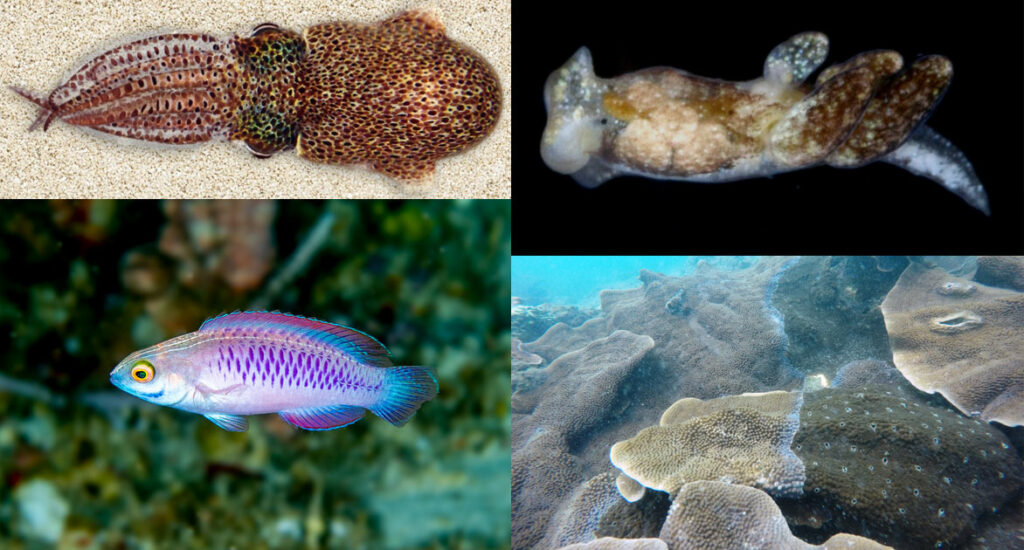
A selection of four out of the ten remarkable new marine species described in 2019, as highlighted by WoRMS. Clockwise from top left: Brenner’s Bobtail Squid (Euprymna brenneri) by Jeffrey Jolly, Okinawa Institute of Science and Technology; Jim Henson’s Egg-Eating Slug (Olea hensoni) by Gustav Paulay; Thomas’ Coral-Eroding Sponge (Cliona thomasi) by Sam Mote; Vibranium Fairy Wrasse (Cirrhilabrus wakanda) by Luiz Rocha © California Academy of Sciences. All CC BY-NC-SA 4.0
via the World Register of Marine Species (WoRMS)
As they have for previous years, the World Register of Marine Species (WoRMS) has again released its annual list of the top-ten marine species described by researchers during the year 2019 to coincide with World Taxonomist Appreciation Day – March 19th!
Ten remarkable new marine species from 2019
- The Green Rat Clingfish, Barryichthys algicola
- Thiel’s Boring Amphipod, Bircenna thieli
- Brenner’s Bobtail Squid, Euprymna brenneri
- The “Star of the Sea” Seed Shrimp, Maristella chicoi
- Jim Henson’s Egg-Eating Slug, Olea hensoni
- The Christmas-Light Brittle Star, Ophiopsila xmasilluminans
- The Mediterranean Branching Placozoan, Polyplacotoma mediterranea
- The Octopus-Dwelling Worm, Spathochaeta octopodis
- Thomas’ Coral-Eroding Sponge, Cliona thomasi
- The Vibranium Fairy Wrasse, Cirrhilabrus wakanda
If you were unaware of this celebration of all the work that taxonomists do, you can find more here: https://twitter.com/hashtag/taxonomistappreciationday, here: https://smallpondscience.com/2014/03/19/today-is-taxonomist-appreciation-day/, and here: https://cetaf.org/news/19th-march-taxonomist-appreciation-day.
Every day in labs, museums, and out on fieldwork, taxonomists are busy collecting, cataloging, identifying, comparing, describing, and naming species new to science. Some 500 experts globally also contribute their valuable time to keeping the World Register of Marine Species (WoRMS) up to date. Today is a chance for us at WoRMS to thank all our editors for this important task. We celebrate the work of taxonomists with the WoRMS list of the top-ten marine species described in 2019, as nominated and voted for by taxonomists and journal editors!
This top-ten list is just a small highlight of almost 2,000 fascinating new marine species discovered every year.
How were the species chosen?
All editors of WoRMS and major taxonomy journals were given the opportunity to nominate their favorite marine species. Nominated species must have been described between January 1st and December 31st, 2019, and have come from the marine environment (including fossil taxa). A small committee (including both taxonomists and data managers) was brought together to decide upon the final candidates. The list is in no hierarchical order.
The final decisions reflect the immense diversity of animal groups in the marine environment (including fish, crustaceans, mollusks, corals, sponges, jellies, and worms) and highlight some of the challenges facing the marine environment today. The final candidates also feature particularly astonishing marine creatures, which are notable for their interest to both science and the public.
Each of these marine animals has a story. This year the chosen species are small, large, hidden, or rather sparkly!
We feature the unusual light-producing Christmas-Light Brittle Star and the Star-of-the-Sea Seed Shrimp; the tiny Brenner’s Bobtail Squid; cryptic Boring Amphipods and Green Rat Clingfish; and even a giant Mediterranean Branching Placozoan (well, giant for a placozoan…).

The Green Rat Clingfish (Barryichthys algicola), by Barry Hutchins. CC BY-NC-SA 4.0
About the WoRMS top-ten list of marine species
After 250 years of describing, naming, and cataloging the species we share our planet with, we are still some way off achieving a complete census. However, we do know that at least 233,000 marine species have been described, because their names are managed in WoRMS by almost 300 scientists located all over the world.
In 2018, to celebrate a decade of WoRMS’ existence, we compiled a list of our top marine species, both for 2017 and for the previous decade, in order to highlight the fascinating discoveries of the numerous new marine species being made every year (see http://www.lifewatch.be/en/2018.04.23-WoRMS-LifeWatch-press-release).
We decided to continue this process every year as a celebration of the work that taxonomists do and of the fascinating marine species that are discovered each year. Our previous lists of the top-ten marine species described for the decade 2007-2017, for 2017, and for 2018 can be found here:
- http://www.lifewatch.be/en/worms-top10-2007-2017
- http://www.lifewatch.be/en/worms-top10-2017
- http://lifewatch.be/en/worms-top10-2018
A list of the top ten species described from ALL habitats and taxa has been announced annually since 2008 (http://www.esf.edu/top10/). The oceans cover over 70% of the surface of our planet, and yet they still include the least explored regions (http://theconversation.com/how-many-undiscovered-creatures-are-there-in-the-ocean-86705). Although the ESF list often contains one or two marine species, we decided to pay homage to the largest habitat on earth by producing our own list of the top marine species.
We hope some of our favorites will make it to the global list!
###




